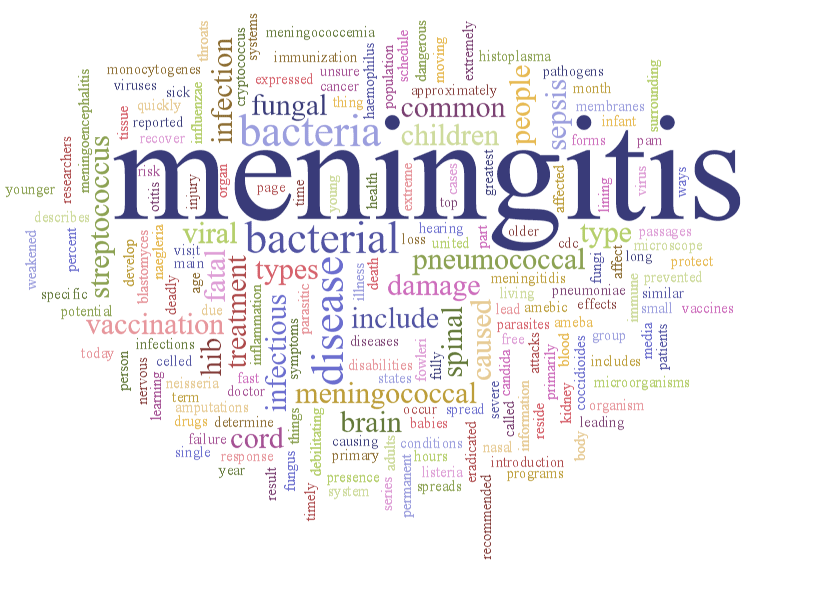Meningitis is most often caused by either a virus or one of several types of bacteria:
Bacterial forms of meningitis can be extremely dangerous and fast-moving and have the greatest potential for being fatal. The long-term effects of bacterial meningitis can include multiple amputations, hearing loss and kidney damage. Many (but not all) forms of bacterial meningitis can be prevented by vaccination.
Viral meningitis has similar symptoms to bacterial meningitis, but for the most part is neither as deadly nor as debilitating. There is no specific treatment available for viral meningitis, but most patients fully recover over time.
Although meningitis is usually caused by bacteria or viruses, it can also be caused by injury, cancer, certain drugs or other microorganisms like fungi and parasites. Please visit CDC’s meningitis page for more information.
Viral meningitis has similar symptoms to bacterial meningitis, but for the most part is neither as deadly nor as debilitating. There is no specific treatment available for viral meningitis, but most patients fully recover over time.
Although meningitis is usually caused by bacteria or viruses, it can also be caused by injury, cancer, certain drugs or other microorganisms like fungi and parasites. Please visit CDC’s meningitis page for more information.
Bacterial Meningitis
Bacterial meningitis is very serious and can be deadly. Death can occur in as little as a few hours. Most people recover from meningitis. However, permanent disabilities (such as brain damage, hearing loss, and learning disabilities) can result from the infection.
Several types of bacteria can cause meningitis. Leading causes in the United States include
Several types of bacteria can cause meningitis. Leading causes in the United States include
- Streptococcus pneumoniae
- Group B Streptococcus
- Neisseria meningitidis
- Haemophilus influenzae
- Listeria monocytogenes
These bacteria can also be associated with another serious illness, sepsis . Sepsis is the body’s extreme response to infection. Without timely treatment, sepsis can quickly lead to tissue damage, organ failure, and death.
The three main types of bacterial meningitis in the U.S. are:
The three main types of bacterial meningitis in the U.S. are:
Meningococcal disease (Neisseria meningitidis)
Meningococcal disease is expressed primarily as either meningitis, an inflammation of the membranes surrounding the brain and spinal cord, or meningococcemia, the presence of bacteria in the blood. Meningococcal disease is the most common type of bacterial meningitis today in U.S. children age 2-18.
The bacteria that cause meningococcal disease reside in the throats and nasal passages of approximately 10 percent of the general population. Researchers are unsure why the bacteria cause some people to become sick while most of the population is not affected.
The bacteria that cause meningococcal disease reside in the throats and nasal passages of approximately 10 percent of the general population. Researchers are unsure why the bacteria cause some people to become sick while most of the population is not affected.
Pneumococcal disease (Streptococcus pneumoniae)
Like meningococcal disease, pneumococcal disease can cause both meningitis and blood infection and it can be serious or fatal. Pneumococcal bacteria can also cause otitis media and other infections. Young children, older adults and those with certain health conditions are at greatest risk for pneumococcal disease. The U.S. immunization schedule for children includes a series of vaccines to help protect them from pneumococcal infection. Some older children and adults are also recommended for pneumococcal vaccination.
Hib (Haemophilus influenzae type b) disease
Hib disease primarily attacks the very young, but has been nearly eradicated in the U.S. since the introduction of infant vaccination programs against Hib in the 1980s. Before the use of vaccination, Hib was the top cause of meningitis in children under the age of five in the U.S.
Viral Meningitis
Viral meningitis is the most common type of meningitis, an inflammation of the lining of the brain and spinal cord. It is often less severe than bacterial meningitis, and most people get better on their own (without treatment). However, anyone with symptoms of meningitis should see a doctor right away because some types of meningitis can be very serious. Only a doctor can determine if someone has meningitis, what is causing it, and the best treatment. Babies younger than 1 month old and people with weakened immune systems are more likely to have severe illness from viral meningitis.
Fungal Meningitis
Fungal meningitis is rare in the United States. It can develop after a fungus spreads from somewhere else in the body to the brain or spinal cord.
Some causes of fungal meningitis include Cryptococcus, Histoplasma, Blastomyces, Coccidioides, and Candida.
Some causes of fungal meningitis include Cryptococcus, Histoplasma, Blastomyces, Coccidioides, and Candida.
Parasitic Meningitis
Various parasites can cause meningitis or can affect the brain or nervous system in other ways. Overall, parasitic meningitis is much less common than viral and bacterial meningitis.
Amebic Meningitis
Primary amebic meningoencephalitis (PAM) is a rare brain infection that is usually fatal and caused by Naegleria fowleri. Naegleria fowleri is a free-living ameba* (a single-celled living organism that is too small to be seen without a microscope.) From 1962–2018, 145 U.S. infections have been reported to CDC with no more than 8 cases reported each year.
Non-infectious Meningitis
Diseases due to pathogens that spread between people, called infectious diseases, are not the only things that can cause meningitis. This page describes some of thing things that can cause meningitis that do not spread from one person to another (non-infectious).
(1) Center for Disease Control and Prevention. Meningitis.
https://www.cdc.gov/meningitis/index.html
(2) National Meningitis Association. Disease and Prevention Information.
https://www.nmaus.org/nma-disease-prevention-information/is-it-viral-bacterial-or-fungal
https://www.cdc.gov/meningitis/index.html
(2) National Meningitis Association. Disease and Prevention Information.
https://www.nmaus.org/nma-disease-prevention-information/is-it-viral-bacterial-or-fungal


